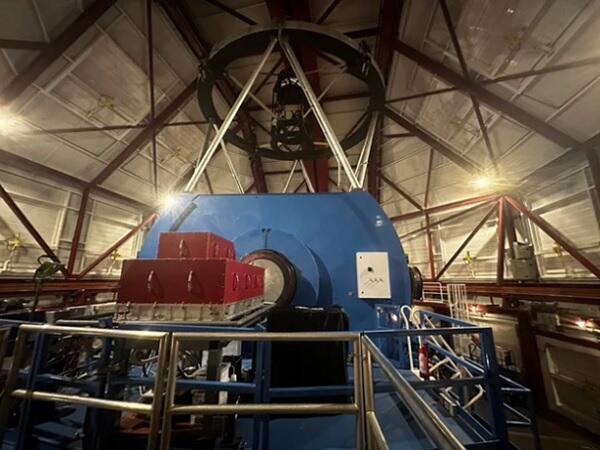Despite the fact that dark matter makes up the bulk of the mass of the universe, its true nature remains a mystery. A collaborative research group has successfully conducted the world's first experiment in order to detect near-infrared photons emitted from the decay of dark matter in a mass range of approximately 1.8-2.7 eV, corresponding to about 1/200,000 of the mass of an electron. The team included Associate Professor Wen Yin of the Graduate School of Science at Tokyo Metropolitan University (assistant professor at Tohoku University until March 2024); Assistant Professor Noriyuki Matsunaga at the Graduate School of Science, University of Tokyo; Research Fellow Shogo Otsubo at Kyoto Sangyo University; Research Fellow Daisuke Taniguchi at the National Astronomical Observatory of Japan; and CEO Yuji Ikeda of Photocross. The observations were conducted using a near-infrared high-dispersion spectrometer WINERED mounted on the Magellan Telescope in Chile, South America. Within less than 4 h of observation, the research team successfully set the lower limit of the lifetime of dark matter with the highest sensitivity ever achieved. This breakthrough has paved the way for new research into eV-scale dark matter, which has been difficult to explore due to technical limitations. These results have been published in Physical Review Letters.

© Koyama Astronomical Observatory
Although the existence of dark matter has been confirmed via various astronomical observations, such as galaxy rotation curves and galaxy cluster motions, its mass and interactions remain unknown even after nearly a century of study. In particle theory, various candidates have been proposed, among which hypotheses involving decaying dark matter in the eV mass range are particularly promising. However, detecting faint light produced from this has long been considered challenging due to the bright background noise.
In 2022, Yin and colleagues introduced a new method that utilizes a high-resolution infrared spectrograph to dim the background noise, which composes a continuous spectrum. This method enables the detection or constraint of line spectra originating from dark matter decay.
In this study, the research team used the near-infrared high-dispersion spectrometer WINERED in an experiment to observe dwarf spheroidal galaxies, which have a high density of dark matter. This experiment demonstrated the effectiveness of this method. WINERED, developed primarily by the University of Tokyo and Kyoto Sangyo University, features high transmittance of up to 50% and a high wavelength resolution, resolving wavelengths to 1/28,000. In the near-infrared region, it offers the highest sensitivity in the world.
The research team selected the dwarf spheroidal galaxies Leo V and Tucana II as the observational targets due to their high dark matter density. They conducted exposure observations for a total of approximately 4 hours. During observations, they used the nodding method, alternately shifting the telescope between the astronomical observation target and dark sky. This method stabilized the optical system and minimized interference from atmospheric radiation, such as airglow and zodiacal light, thoroughly eliminating background noise. They also accounted for the Doppler effect, which causes wavelength shifts due to relative velocity. By analyzing data from multiple dwarf galaxies with different relative velocities, they successfully removed systematic emission and absorption of bright lines arising from the Earth's motion.
The dark matter distribution is a theoretical model indicating the distribution of the dark matter density in the galaxy. For this distribution, they used multiple models, including uncertainties, to estimate the dark matter number density at the observation coordinates. Through analysis, they determined the noise level in the wavelength ranges where no significant signals of narrow lines (line spectra) were detected in the observation data. This allowed them to establish extremely strict lower limits on the dark matter lifetime and upper limits on its coupling with photons.
As a result, they found that dark matter with a mass between 1.8 and 2.7 eV, decaying into two photons, had a lifetime of at least 1025-1026 s under a standard NFW distribution. This lifetime is 107-108 times longer than the universe's age of 13.8 billion years and surpasses previous upper limits derived from Hubble Space Telescope data analysis. Although not included in this announcement, they detected potentially significant signals in small wavelength ranges. They plan to conduct follow-up observations and further analysis to clarify their nature.
Journal Information
Publication: Physical Review Letters
Title: First Result for Dark Matter Search by WINERED
DOI: 10.1103/PhysRevLett.134.051004
This article has been translated by JST with permission from The Science News Ltd. (https://sci-news.co.jp/). Unauthorized reproduction of the article and photographs is prohibited.




